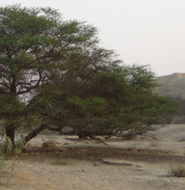In a study published today in PLOS ONE, Dr Marc Holderied and colleagues from Bristol's School of Biological Sciences and Ben-Gurion University of the Negev, Israel demonstrate the importance of dense acacia tree habitats for protected bats and their arthropod prey (for example, insects, spiders and scorpions) in comparison to other natural and artificial habitats.
The researchers used acoustic monitoring of bat calls and collecting arthropods using light and pit traps to sample species. They found that, where acacia trees are most dense and healthy, bat activity and species diversity are highest. Since arthropod numbers didn’t vary the same way between the different habitats investigated, the researchers conclude that the greater bat diversity at acacia trees is not solely a result of differences in prey numbers. In the hottest and driest times of the year, only healthy acacia trees maintained high prey numbers showing their particular importance during such bottlenecks in food supply.
Exclusively at healthy acacia trees, the researchers captured recordings of two very rare bat species: Nycteris thebaica and Barbastella leucomelas, a species which has only been recorded five times previously in Israel.
As predicted, the artificial habitats that were studied – date plantations and village sites – also had high levels of insect and bat activity. The well-irrigated and lit environments attract arthropods and consequently the insectivorous bat predators. However, in these environments, species diversity of bats was reduced and biased against species typically found in deserts.
Talya Hackett, lead author of the paper, said: "While man-made environments could represent a suitable alternative foraging environment for some species of bat, many of the more threatened species were only recorded at the declining acacia habitat. This highlights the importance of increasing conservation efforts of dense acacia habitats to protect this vital ecosystem for an entire diverse community of protected bats."
Because of their expertise in acoustic monitoring of bats in Middle Eastern deserts, Dr Marc Holderied and Talya Hackett were invited to lead a UNEP Eurobats-funded workshop hosted by Jordan's Royal Society for the Conservation of Nature last summer. This workshop, which took place in nature reserves in Jordan, was organised to train wildlife biologists from countries of the Middle East in bat acoustic monitoring so they could apply these skills to improving bat conservation.
Paper
'The importance of Acacia trees for insectivorous bats and arthropods in the Arava desert' by Talya D. Hackett, Carmi Korine and Marc W. Holderied in PLOS ONE

